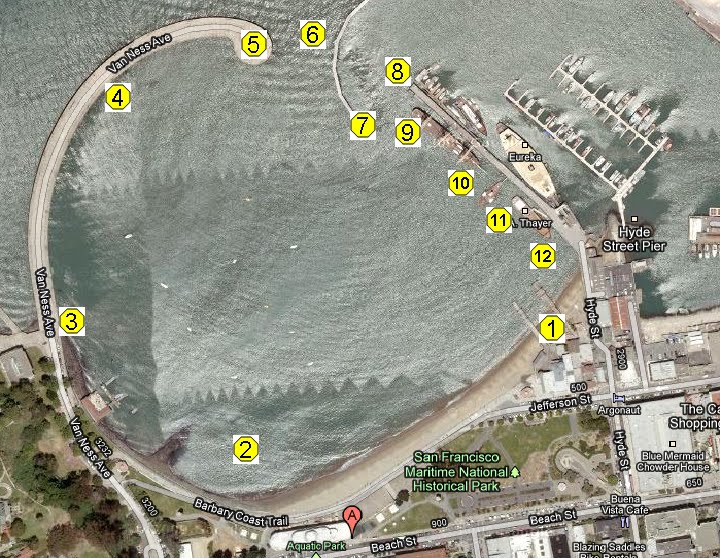Thursday 12/10/09
Coach Val has been giving me stroke advice and correction. He teaches the same way that Clint Eastwood reportedly directs movies—simple, direct, and succinct. Last week, at the end of two hours, he stood at the end of my lane and said, “Larry!” Once he had my attention, he said, “Stroke getting better.” Then he held his arms over his head with his hands about three feet apart and said, “Was like this.” Then he moved his hands two feet apart and said, “Now like this.” Then he moved his hands six inches apart and said, “Make like this.” Then he walked away.
Tuesday, I did another two hour swim at Koret. Coach started me off with a 500 yard freestyle warm-up. Then he had me do eight iterations of 800 yard intervals with a 50 second rest between each. He ended this with kicking four short lengths. This workout put me well ahead of schedule for two hour swims. It was still early morning when I got back to my office. I updated the planning calendar with a more aggressive schedule, including a five hour swim in the pool in March. Writing these numbers on the laminate immediately boosted my confidence for meeting or exceeding my Bay goals when the water starts warming up in April.
During one of the rest periods between the 800’s, Coach said, “Stroke is better. Keep practicing.” I was thrilled. I like to think of myself as a quick study and have been disappointed that I can’t seem to immediately implement the stroke guidance he’s been volunteering. This morsel of praise was delectable.
At the end of the session, though, Coach said, “Larry! Listen to me—very important. When you get tired, you go back old way swimming. It will take you 14 or 15 hours to swim Channel. Concentrate when tired. Practice all the time—at home—in Bay.” Discouraging as it was to hear, the criticism goaded me to redouble my attention to stroke mechanics.
Back in the pool on Thursday, Coach started me with 250 yards of freestyle in a lane by myself. He came over after a few laps; smiled; and said, “Very good. Making progress.” It was fortunate that I was wearing only a standard swimming costume as my swelling chest encountered no buttons to bust.
Then he had me do 2,500 yards of catch-up drill. “You know catch-up?” he asked. He pantomimed a freestyle stroke where both hands are raised straight above the head and touching one another. Then the left starts its downward motion, tracing as much of the centerline of the body as it can reach. All the while, the right hand stays extended high above the head until the left catches up and plays “tag, you’re it.” Triggered by this touch, the right hand begins its own downward descent and dissection of the body’s centerline until it returns high above the head to greet the patiently waiting left. He repeated this motion a couple of cycles and then grinned wolfishly at me. “Will make it impossible to do this.” At which point he rotated both arms wildly away from his body in a frenzied imitation of the stroke I’d originally brought to his pool.
Executing the first couple of hundred of yards of this drill, my stroke rate was about half of normal. In order to get adequate air, I had to breathe on every stroke. This led to the exhilarating discovery that breathing on the left didn’t feel nearly as awkward doing the catch-up stroke. My entire body was rotating a full 180 degrees with each stroke, making getting a breath on either side more natural. I then concentrated on increasing my stroke rate to near-normal while diligently touching each hand to the other. It felt like I was jetting forward at the end of each stroke, much like the feeling of a jet turn on snow skis in hip-deep powder. And the improved bi-lateral breathing comfort came with no additional charge.
Coach cruised by from time to time with a huge smile on his face, giving me two enthusiastic thumbs up. At one point he stopped and showed me a dry land version of front-quadrant swimming. He demonstrated a stroke that was “nearly catch-up.” The hands never actually touched, but both arms were well above shoulder level before the stroke was initiated. As his arms swung gracefully over his head, he began to bounce his torso up and down in rhythm, giving a dry land illustration of the jetting effect. Then he started chanting, “one … two … one … two” and stepping lightly from side to side as if doing the Texas two-step. With a big grin he said, “This is real freestyle.”
I was in the pool for less than an hour and a half, but was becoming absolutely pooped. In order to rest, I’d periodically slow my rotation rate back down to half-normal and still focus on touching one hand to the other and cleaving the body’s centerline with each stroke. As I tired, I felt an increasing urge to jettison the straightjacket of the graceful, balletic style and return to my wanton, boogie-woogie roots. This was plenty for one day as far as I was concerned.
Coach asked me to bring a video recorder to the next session. He said, “You’re ready for next step.” I was too tired to ask what the next step might be. There was a single predominant thought coursing through my brain. I probably needed another 50,000 yards of catch-up drill if I'm going to build the requisite “real freestyle” muscles and permanently excise the last vestige of the boogie-woogie stroke from my mind. After all, it’s a long way across that ditch.
6 years ago


No comments:
Post a Comment